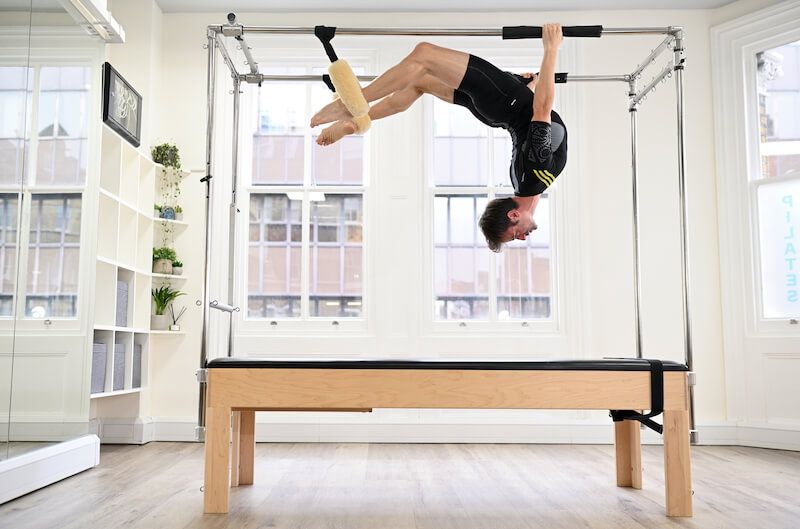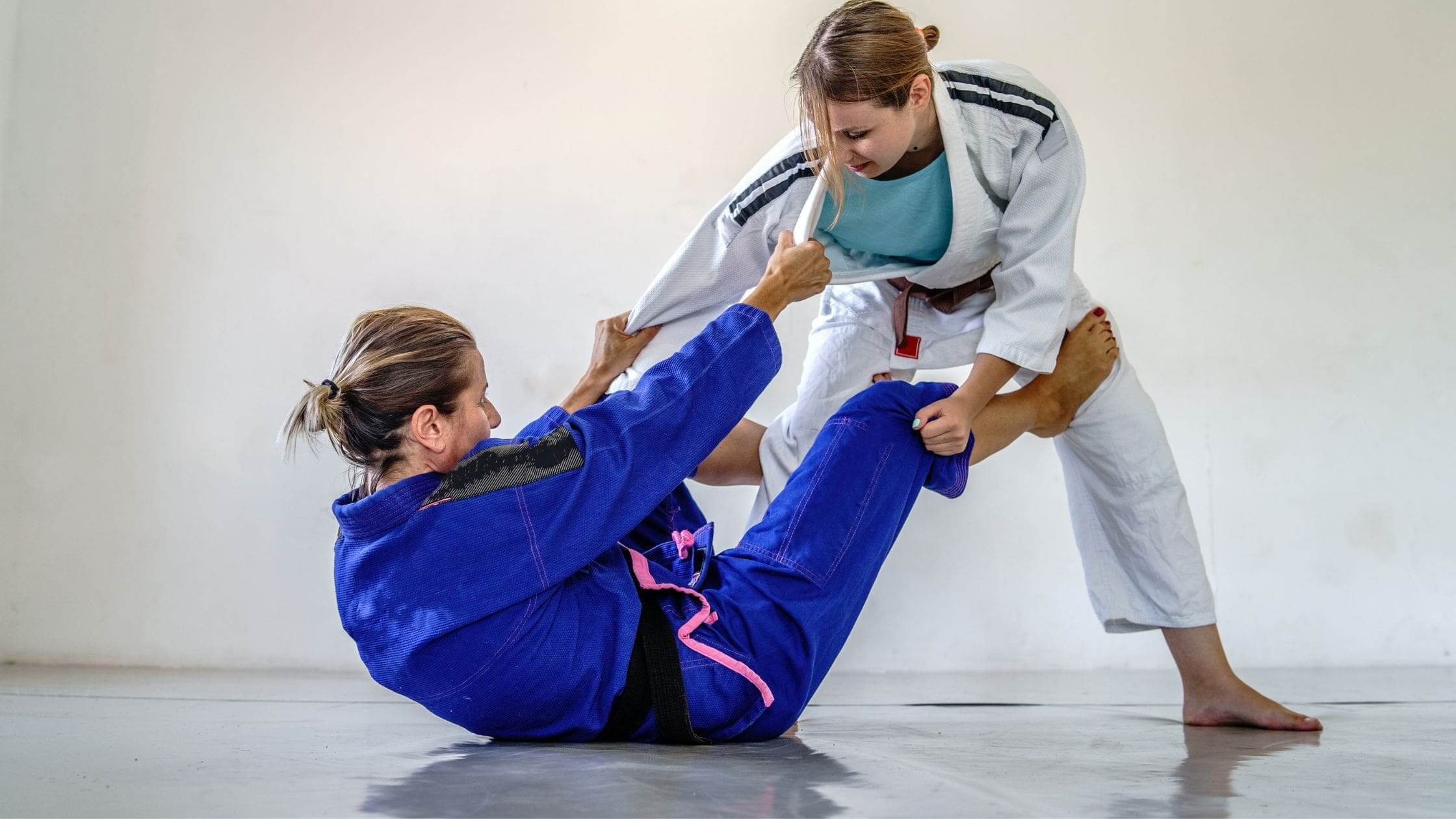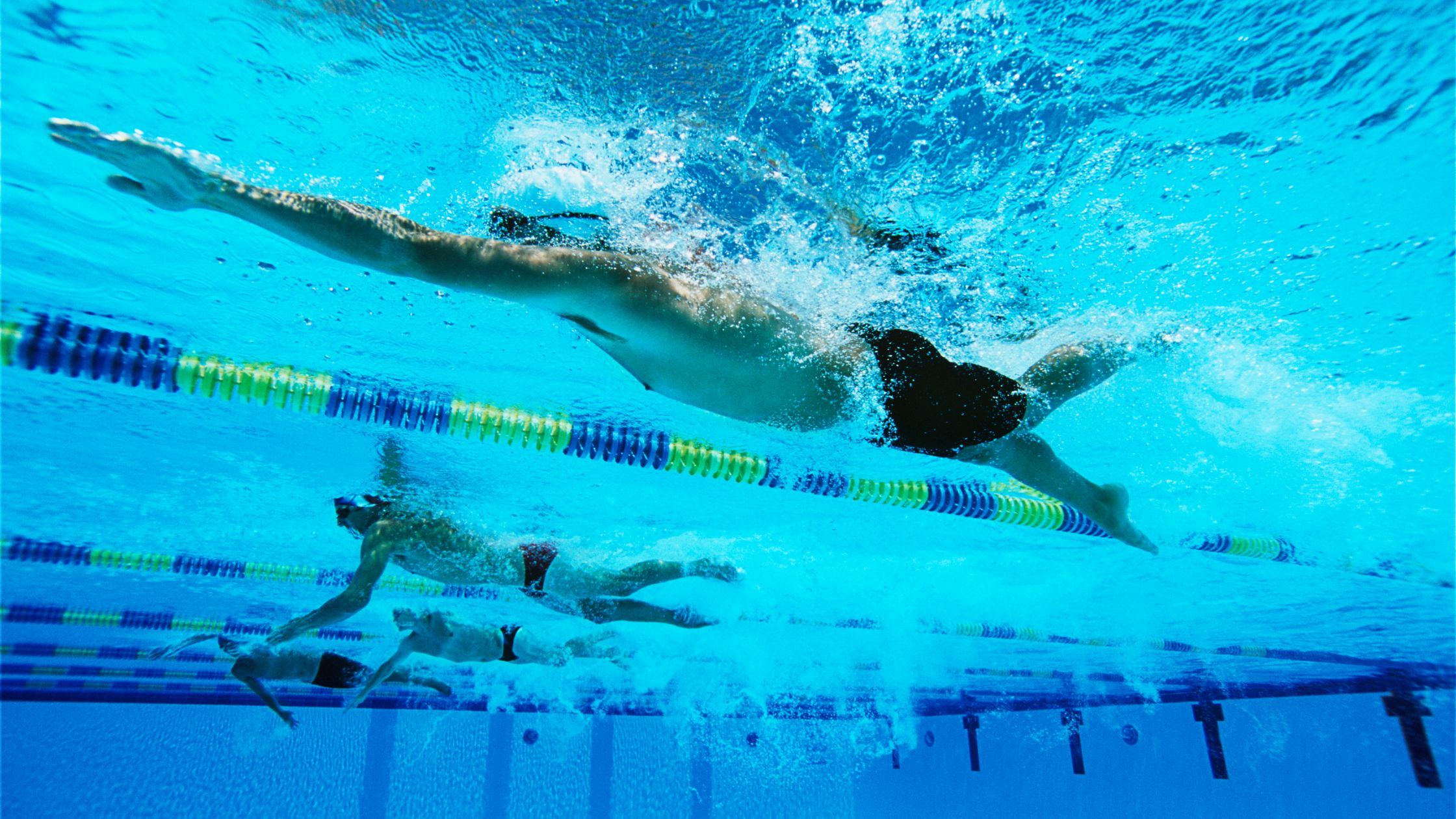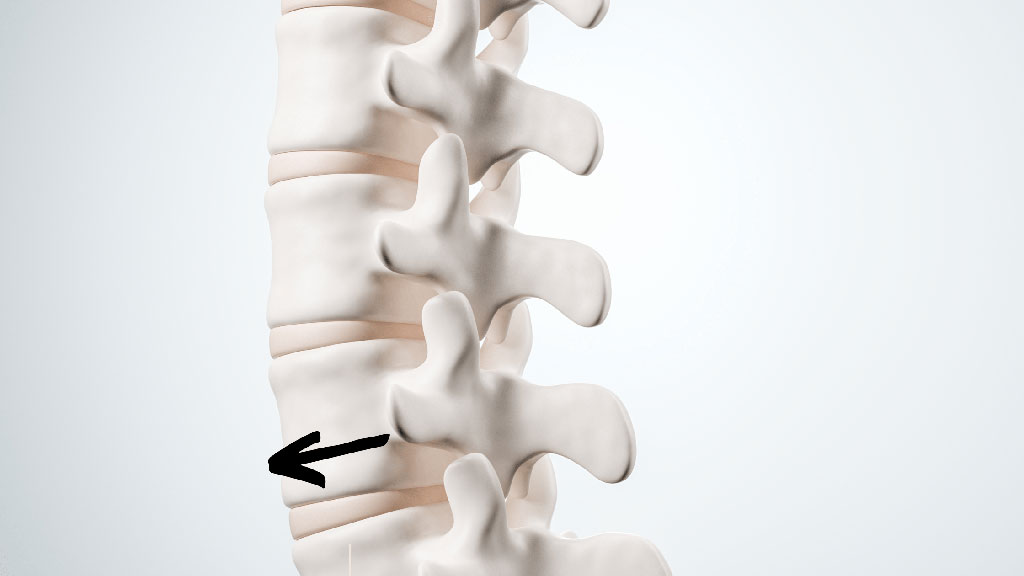Have you ever been to a Yoga or Pilates class? If the answer is “yes” then chances are you’ll have already experienced Pilates inversion exercises.
You might not know it though.
Because an inversion is anything that brings your hips above your heart and your heart above your head. So, although this could mean something as advanced as a Yogic handstand, it also includes simple Yoga moves like Downward Dog and Child’s Pose.
There are also many inversions in the Pilates repertoire. Typical exercises include the Leg Series on the Spine Corrector, Hanging on the Trapeze Table and Roll Over on the mat.
Although more commonly associated with Yoga, these types of exercises are as integral to the Joe Pilates method as they are to that ancient practice. After all, one of Pilates’s main aims are to move the body in all planes, directions and orientations. The addition of an inversion to a mat or equipment class is the perfect way to achieve this.
How to do an inversion exercise
If you are new to inversion exercise then aiming for a full inversion may not be the best place to start particularly if you are older or have not been exercising regularly. There are many different types of inversion exercises so a good starting point is to think about what your end goal is and work back from there.
You can then start with the simpler or more supported inversions and work your way up to more challenging ones to see how your body responds.
For example, if you are planning to work towards a shoulder stand – starting with bridging on the mat or lying on the floor resting your legs on the wall could be a good option. In the Pilates studio you could work up to the leg spring series or parakeet on the trapeze table to bring you into positions where your hips and legs are lifted.
Finally, you can perform shoulder stand variations on the reformer with the legs supported in straps – called ‘short spine’ or ‘long spine’.
When you are venturing into the world of inversions, it is a good idea to practise them for short periods of time so that your body can become accustomed to these positions and then gradually build up to longer periods of time.
It is a good idea to practise all but the most basic of inversions under expert guidance. Some more advanced inversions can be difficult to get in and out of unaided, whilst others can place stresses in unwanted areas, such as the neck if not performed with awareness of good techniques.
Having guidance under an instructor also means that inversions can be modified on the spot to suit your individual capability.
4 Benefits of Invesion Exercises
But inversions aren’t for everyone. They should be avoided by people with high blood pressure, acid reflux, spinal instabilities and glaucoma. If you’re unsure, check with your healthcare provider before attempting one.
For those of you ready to turn your world upside down, however, here are 4 surprising benefits of inversions to motivate you.

1. Inversion exercises promote spine health
Gravity acts upon your body all day long. This downward pressure compresses the spine and dehydrates the sponge-like disks that separate the vertebrae. These disks act as shock absorbers; they protect the spine and spinal nerves. When they become dehydrated, however, the spine becomes less mobile and is at greater risk of injury.
On top of all that, spines usually have to deal with further stresses in the form of heavy bags and hunched computer postures.
With this in mind, it’s little wonder that so many people suffer with spine-related issues.
But inversions can help combat these problems and ease stiff backs.
How? Well, when you tip your body upside down you immediately reverse the pull of gravity. This helps to decompress the spine and create space between the vertebrae.Studies show that this then allows for the absorption of moisture into the soft tissue of the discs. This rehydrates and plumps the discs.
And the benefits of inversions for back health don’t end there. Certain Pilates exercises like Roll Over on the mat and Short Spine on the Reformer support the spine in other ways.
In both cases, the act of rolling the spine against a cushioned surface acts as a massage for the muscles and fascia of the back. Plus, through regular practise, these types of inversions improve flexibility of the spine and abdominal strength.
2. Inversion exercises boost lymphatic drainage
According to many experts, inversions support the lymphatic system.
This is important because a functioning lymphatic system is vital for our wellbeing by helping us maintain a healthy immune system. It does this through acting like the body’s drainage system by cleansing it of cellular waste. More specifically, lymph fluid (comprised of vessels that make up the lymphatic system) carries toxins from cells to the lymph nodes where they are removed.
Unlike the circulatory system, however, the lymphatic system has no heart to pump it around the body. Instead, this system relies on the movement of muscles and breath to get it flowing.
Which is where inversions come in. Flipping your body the wrong way up is said to stimulate the flow of lymph and therefore aid this cleansing process.
3. Inversion exercises aid digestion
Humans have the tricky task of having to push waste matter through their digestive system against gravity. But inversions can help give your belly a break.
Changing the way gravity acts on your stomach can assist the movement of waste through the ascending colon. Doing so also helps stimulate stronger peristalsis (the muscle contractions in your digestive tract), which further assists the digestive process.
As with twists and gentle stomach massages, inversions can also increase blood flow to the stomach. This is equally beneficial when it comes to digestion.
Just make sure to avoid inversions when you’ve just eaten!
4. Inversion exercises reduce muscle tension
Tense muscles can cause a whole a host of problems. These can range from the physical to the psychological; from headaches and sore backs to feelings of stress. However, inversions may help to reduce muscles tension and with it these problems.
When your muscles are tense, the supply of oxygen to them is restricted. Tense muscles can also affect the flow of lymph around the body. As we’ve already mentioned, this is bad for the body as lymph needs to move freely so that it can cleanse the body of toxins. And there are other issues with stagnant lymph, including – as some research suggests – slowing muscle recovery time after exercise.
This explains the findings in a study by physiotherapist L.J Nosse. In it, Nosse showed that boosting both oxygen circulation to muscles and lymphatic flow through inversions can help to reduce muscle tension.
According to that study, EMG (electromyographic) activity, an indicator of muscle tension, declined over 35 degrees within ten seconds of inverting.
But you don’t need to go as far as a handstand to experience these benefits. Positive effects in trial participants were noted even when only inverted 25 degrees. This means that something simple like an inverted V (pictured above) could be enough to reap these benefits.
Less muscle tension usually means less stress. So, get inverting (safely!) and enjoy the relaxation that follows.
What muscles do you use for inversion exercises?
There is no single answer to this question because there are so many different inversions that you can do. An inversion is simply an exercise where your head is below your hips – and so this could be anything from bending forwards as if touching your toes, to a bridge pose, to a full head or handstand. The muscles used in all of these exercises are very different.
Inversion exercises are less about using particular muscles and more about varying your everyday movements and to change the relationship of your body to gravity.
Some inversions are very passive, requiring very little muscle work – for example – hanging upside down in the fluffy cuffs on the trapeze table. This exercise decompresses the spine and can be relaxing.
Other inversions, such as the headstand, require lots of upper body strength. This is really important for reducing pressure on the neck.
Headstands and handstands require activity of the muscles that stabilise the spine, such as the deeper abdominals and tiny muscles that link each vertebra. These are muscles that are designed to work for long periods of time at low levels and we don’t necessarily feel them working, unlike our large arm and leg muscles that we might use for lifting weights. our more superficial muscles that tend to be required for lifting heavy loads.
A more active and challenging inversion like a headstand is not just about strength but about fine body awareness and being able to make tiny shifts in your weight to adjust your balance so that you don’t fall over.
What are the risks of inversions?
If performed with due care, inversions should be safe for most healthy people. If you have any of the conditions previously mentioned, it is not recommended to do inversions as they may exacerbate symptoms or compromise your health. You should consult with a health professional if you are not sure what is safe.
If you are otherwise healthy and performing an advanced inversion for the first time, it would be recommended to do this under the guidance of a professional.
For example, in learning to do something like a headstand or shoulder stand, it is useful to know how to get more weight onto your arms and reduce any stress on the head and neck. This will reduce the risk of injuries to or discomfort of the neck.
There is no specific research relating to Pilates inversions but research into adverse events associated with yoga found that most adverse events were related to shoulder stands and headstands although it was not clear from this research how many of the events were related to the exercise being an inversion as opposed to the exercise being challenging in another way.
The same research also found that adverse events were were also more likely to occur when exercisers were practising unsupervised or had pre-existing medical conditions.
Inversion Modifications
The repertoire of equipment Pilates has so many options for exercises that you can experience exercises that give the benefits of inversions but with less of the risks.
Shoulder stand
The safest alternative to shoulder stand in Pilates is supine leg series on the trapeze table or feet in straps on the reformer. These exercises place the legs above the heart so it has a similar, but more gentle, effect on the circulation and places no pressure on the neck and should not affect blood pressure or ocular pressure.
A progression on from this exercise is breathing or parakeet on the trapeze table. These exercises do not require the position to be sustained, as a shoulder stand might be, making them easier to tolerate. They also place less pressure on the neck and shoulders than a shoulder stand.
Standing roll down
For those who may have had back pain and who are nervous about forward bending, a version of standing roll down using the Pilates chair provides a nice alternative. Using the pedal of the chair the weight of the upper body is supported, so the back muscles have less load to carry and this exercise can be a good way to introduce forward bending and to gradually build up confidence.
Headstand
The headstand is a great exercise for shoulder strength but may be difficult for people with neck pain to tolerate, or may cause neck pain for those who do not yet have sufficient strength in the shoulders.
Plank to pike exercises on the forearms on the Reformer are a great way of building the shoulder strength necessary for a headstand but without the added pressure on the neck. They also do not require being upside-down for a sustained period of time.
Hanging
The hanging exercise in Pilates involves full upside down suspension from the fluffy cuffs on the trapeze table. This is advanced exercise that is not for the faint-hearted. Instead, half hanging is a safer variation which allows you to experience the benefits of decompressing the spine but in a very supported way.
Conclusion
Inversions can be a fantastic addition to your movement routine. Being upside down can literally give you a whole new perspective. Inversions are a great way to counteract the effects of gravity on the body – by providing the opportunity to decompress the spine.
Inversion exercises can help with circulation and lymphatic drainage. They can provide a new challenge to the body because it is harder to know where you are in space when you are upside down.
However, inversions can also be challenging exercises and are best undertaken under the guidance of an exercise professional. If you have any relevant medical conditions it is also essential to consult with a health professional before attempting inversions as they may not be appropriate for you.
Join us at Complete Pilates
Want to find out more about the Pilates inversion exercises? Join us for Pilates in Angel, Pilates in Chelsea and Pilates near London Bridge to find out more about how the Pilates hundred exercise can help you.
Resources:
- http://stm.sciencemag.org/content/4/119/119ra13
- https://www.vodderakademie.com/fileadmin/pdf/vodder/Studien/STU_ART_4_Study_MLD_Effective_for_Injuries.pdf
- https://www.ncbi.nlm.nih.gov/pmc/articles/PMC4681911/
- https://www.ncbi.nlm.nih.gov/pubmed/16715021
- https://www.ncbi.nlm.nih.gov/pmc/articles/PMC5361017/
- https://www.ncbi.nlm.nih.gov/pubmed/687049
Curious to experience inversions under the supervisions of experts? Then why not book in for a 1-2-1 session
Education is key:
These blogs are designed to give information to everyone, however, it is important to remember that everyone is different! If you have not seen one of our therapists and have any questions about injuries, what you have read or whether this may be useful to you, please just ask. We are more than happy to help anyone and point you in the right direction. Our biggest belief is that education is key. The more you understand about your injury, illness and movement, the more you are likely to improve.







